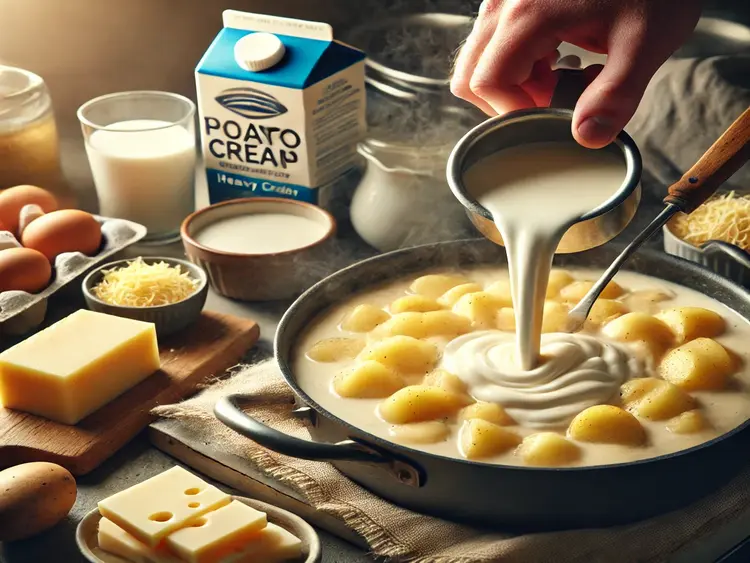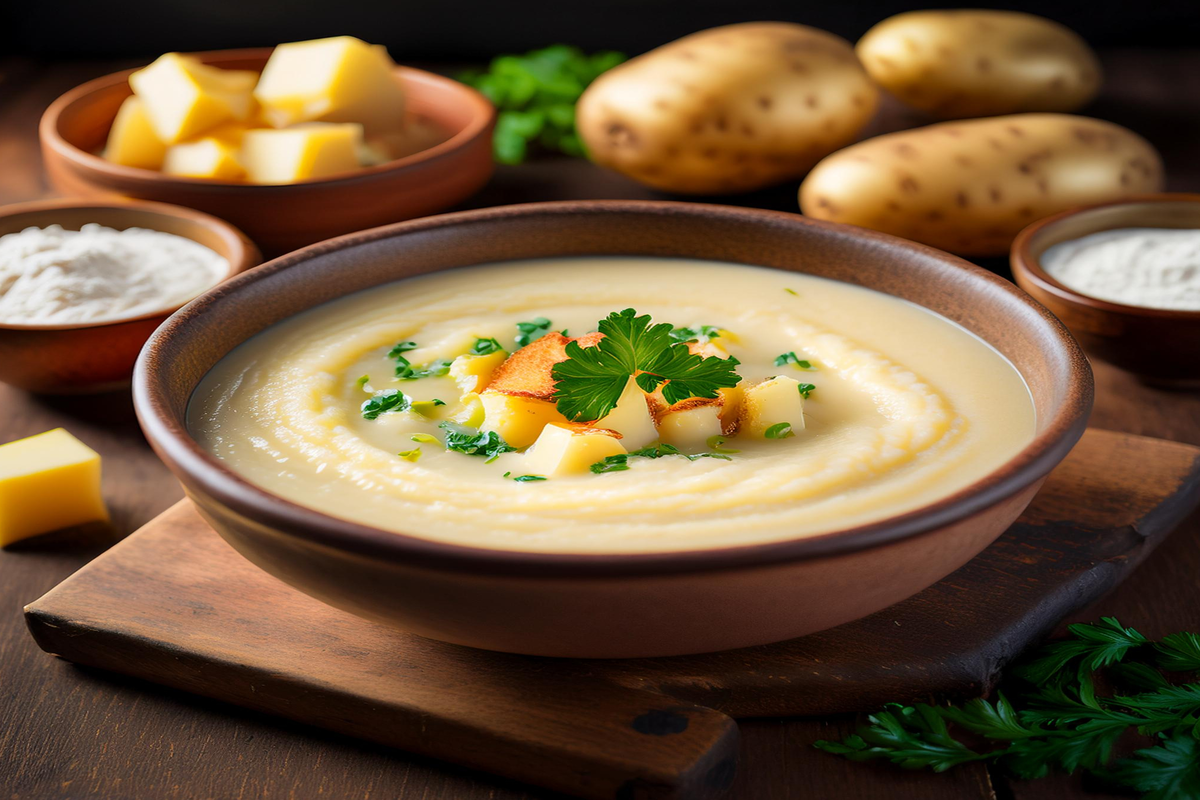A creamy, hearty bowl of potato soup is a comforting dish that many people enjoy, especially during colder months. However, if your soup turns out too thin or watery, it can be disappointing. So, what thickens potato soup? There are several effective ways to thicken potato soup, ensuring you get that perfect, rich consistency every time. This guide will explore the best methods to thicken your soup, along with helpful tips for avoiding common mistakes. Whether you’re using flour, potatoes, or a gluten-free alternative, these methods will elevate your soup-making game.
For a comforting variation, check out our Hash Brown Potato Soup Recipe.
Why Thickness Matters in Potato Soup
The texture of your potato soup can significantly impact its flavor and overall satisfaction. A thin, watery soup may lack the comforting, velvety feel you’re aiming for. On the other hand, a properly thickened soup adds creaminess and body, making every spoonful more satisfying.
In fact, thickening your soup helps balance the flavors, ensuring that each ingredient stands out. Whether you’re adding chunks of bacon, cheese, or veggies, a thicker base allows these elements to shine. For many people, the key to achieving a perfect potato soup is mastering the art of thickening it to their desired consistency.
If you’re looking for additional methods to perfect your soup, Recipes.net offers helpful tips on how to thicken potato soup. If you’re curious about other dishes that involve potatoes, explore our article on Are Hash Brown Potatoes Good for You?.
The Role of Potatoes in Thickening Soup
When wondering what thickens potato soup, the answer often lies in the potatoes themselves. Potatoes naturally contain starch, which can act as a thickening agent as they cook. By using starchy potatoes, like Russet or Yukon Gold, you can allow the natural starches to release into the broth, thickening the soup without needing extra ingredients.
In addition, mashed potatoes work wonders as a natural thickener. You can either mash a portion of the cooked potatoes or blend them with a hand blender before adding them back into the pot. This not only enhances the thickness but also keeps the soup creamy and smooth.
Alternatively, adding pureed potatoes is another way to thicken potato soup without changing the flavor or texture drastically. The potatoes’ starch will help create a thicker, more cohesive soup that retains its natural potato flavor. For more expert guidance on thickening soup with potatoes, Eating on a Dime offers helpful suggestions. If you’re interested in perfecting other potato-based recipes, check out our guide on What is the Secret to Making Good Hash Browns.
Using Dairy to Thicken Potato Soup

Dairy products like heavy cream or milk are common thickeners in potato soup. Adding dairy helps not only to enhance the creaminess but also to contribute to a richer and thicker consistency. The fat content in these dairy products coats the starch molecules from the potatoes, creating a velvety texture that many love in their soups.
If you prefer a dairy-free alternative, coconut milk or almond milk can also be used. While these options may not thicken the soup as much as traditional cream, they still add a level of richness. Keep in mind that certain dairy-free options may slightly alter the flavor, but in most cases, the creaminess they offer is worth the switch.
For more details on methods for thickening potato soup with dairy and non-dairy alternatives, check out this helpful MasterClass article. Also, for tips on using dairy in steak-based recipes, check out Why Do You Soak Cube Steak in Milk?.
Flour-Based Methods: Roux and Beurre Manié
A classic method for thickening soups, including potato soup, is to use a roux. A roux is made by mixing equal parts of flour and fat, such as butter, and cooking them together until you achieve a paste-like consistency. This paste is then gradually incorporated into the soup to create a thicker, richer texture.
- To make a roux:
- Melt butter in a saucepan over medium heat.
- Add an equal amount of flour.
- Stir continuously until the flour is cooked, creating a smooth paste.
- Slowly whisk in the soup liquid to prevent lumps.
For those who want a quicker option, a beurre manié (French for “kneaded butter”) works similarly but is added at the end of the cooking process. You combine softened butter and flour into a paste, then stir it directly into the soup, allowing it to thicken as it simmers.
Flour-based methods are great for creating a hearty soup, but be cautious of over-thickening or using too much flour, which can make the soup heavy. For more on the benefits of using a roux, check out this expert guide on thickening potato soup.
Common Mistakes to Avoid When Thickening Potato Soup
While there are many ways to thicken potato soup, some mistakes can affect the final texture:
- Over-thickening the soup: Adding too much thickener, such as flour or cornstarch, can lead to an overly dense and gluey consistency. Fix this by adding more liquid, such as broth or milk, to balance the texture.
- Using the wrong potatoes: Waxy potatoes (e.g., red or fingerling) don’t release as much starch, so avoid using these if you want a thicker soup.
- Skipping the simmering step: If you add flour or cornstarch to your soup without simmering it long enough, it won’t thicken properly. Always allow time for the soup to cook and absorb the thickener.
For more tips on making tender meat dishes without mistakes, check out Can You Put Raw Steak in a Slow Cooker?.
Thickening Soup Without Flour
If you’re gluten-free or simply prefer not to use flour, there are plenty of alternatives. The most popular flour-free options include cornstarch, arrowroot, and potato starch. These thickeners are effective and easy to use without altering the flavor or texture.
- Cornstarch slurry: Mix cornstarch with a small amount of cold water to create a slurry. Slowly add this to the simmering soup while stirring continuously.
- Arrowroot: Like cornstarch, arrowroot works well for gluten-free soups. It thickens without giving the soup a cloudy appearance, which makes it perfect for those who prefer a clear, glossy finish.
- Potato starch: A natural option derived from potatoes, this starch helps thicken soups while maintaining a potato flavor.
These options work just as well as flour, but you may need to use them in different quantities. For more details on gluten-free soup thickening, check out Recipes.net.
Thickening Potato Soup with Cheese
Cheese not only adds flavor but can also act as a thickening agent. By stirring in shredded cheese toward the end of cooking, you can create a thicker, creamier texture while adding a rich, savory note to your potato soup.
- Cheddar, Parmesan, and Gouda are popular cheese varieties for thickening soup.
- Remember to add the cheese in small amounts and stir continuously to prevent it from clumping.
Cheese adds both thickness and flavor, making it an excellent option for those who want to take their soup to the next level. Looking for more creative ways to thicken potato-based recipes? Explore Deer Cube Steak Recipes for ideas on incorporating hearty, thick textures into your dishes.
How to Fix Overly Thick Potato Soup
Sometimes, you may accidentally make your potato soup too thick, resulting in a dish that feels more like mashed potatoes than a soup. The good news is that this issue is easy to resolve. One simple method is to add more liquid. Use a small amount of broth, milk, or cream, depending on the flavor profile you want to maintain. Gradually stir the liquid into the soup, allowing it to thin out until you reach the desired consistency. If you prefer a lighter soup, water can also be used without impacting the flavor too much.
Another trick is to incorporate more ingredients that help balance out the texture. Adding cooked vegetables, such as carrots or celery, or even extra potatoes can help balance the thickness. This not only thins the soup but also adds more flavor and texture, enhancing the overall dish. If you’re looking for more hearty ideas, check out Can You Put Raw Steak in a Slow Cooker? to see how adding extra elements to a dish can affect the outcome.
When to Add Thickeners in Potato Soup
Timing is essential when using thickeners in potato soup. If you’re using methods like a roux or a cornstarch slurry, it’s important to add these at the right stage of cooking. For example, a roux is typically made early in the cooking process and incorporated gradually into the liquid, allowing it to thicken as the soup simmers. On the other hand, a cornstarch or arrowroot slurry is usually added near the end of cooking, as it thickens quickly once heated.
Adding thickening agents too early or too late can impact the texture of the soup. If added too early, the soup might become overly thick as it continues to cook. Adding them too late might not give the soup enough time to absorb the thickener fully. Always consider the type of thickener you’re using and the desired final texture. If you’re experimenting with other ingredients, be sure to visit our guide on Deer Cube Steak Recipes for timing tips in similar recipes.
FAQs: What thickens potato soup:
What thickens potato soup naturally?
The starch in potatoes acts as a natural thickener when cooked. You can also use mashed or pureed potatoes to thicken the soup.
Can I use mashed potatoes to thicken potato soup?
Yes, mashed potatoes are a great way to thicken soup without adding extra ingredients.
How do I make my potato soup creamier?
Adding heavy cream, milk, or cheese will create a creamier texture in your potato soup.
What’s the best gluten-free option to thicken soup?
Cornstarch, arrowroot, and potato starch are all effective gluten-free thickeners for soup.
Conclusion: Mastering the Art of Thickening Potato Soup
In conclusion, what thickens potato soup depends on your preference and the ingredients available. Whether you’re using natural starches from potatoes, adding cream for extra richness, or experimenting with gluten-free thickeners like cornstarch or arrowroot, there are numerous ways to achieve that perfect texture. With a bit of trial and error, you’ll be able to find the method that works best for your tastes, ensuring thatIn conclusion, what thickens potato soup depends on your preference and the ingredients available. Whether you’re using natural starches from potatoes, adding cream for extra richness, or experimenting with gluten-free thickeners like cornstarch or arrowroot, there are numerous ways to achieve that perfect texture. With a bit of trial and error, you’ll be able to find the method that works best for your tastes, ensuring that every bowl of potato soup is as satisfying and comforting as possible.

1 thought on “What Thickens Potato Soup? Best Methods for a Creamy Soup”